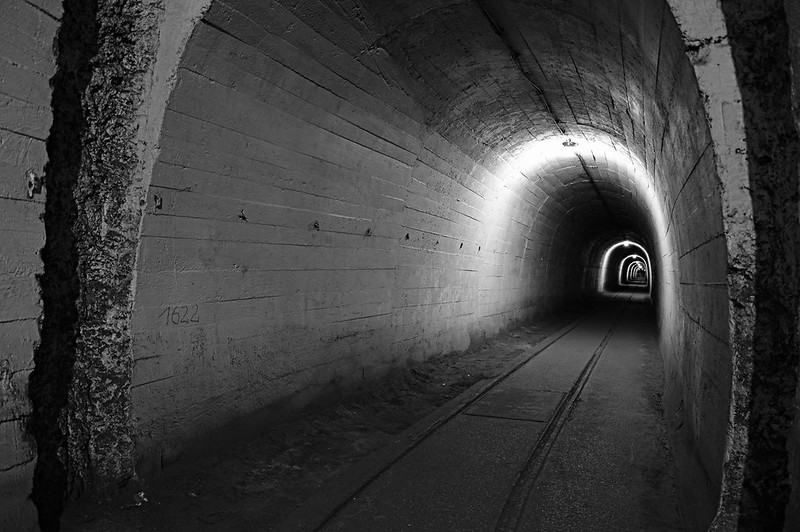The MRU, a mysterious underground city of nazi Germany with 80 km of tunnels
Of all the WWII military ruins in Europe, one of the most impressive and enigmatic is in Poland.
These ruins are located in the Lubusz Voivodeship in western Poland, in an area that until World War II was part of Germany. In the spring of 1934, after Hitler's rise to power, construction began there on some underground military facilities that are made up of 80 kilometers of tunnels. Its official name was Festungsfront Oder-Warthe-Bogen (Oder-Warthe-Bogen Fortification Front) , although colloquially it was known by the more shortened name of Ostwall, the Eastern Wall.

As the name suggests, this network of tunnels was made to create a defensive fortification. Its construction, which was intended to cover the area between the Oder and Varta rivers, was a violation of the Treaty of Versailles, which expressly prohibited Germany from building fortifications in border areas.

Today in Poland it is known as the Międzyrzecki Rejon Umocniony (MRU, Międzyrzecz Fortified Region), because the central section of this tunnel network was near the present-day Polish city of Międzyrzecz. In that area alone, the central section of the MRU was made up of a 32 km network of tunnels located 40 meters underground.

Much of the MRU tunnels were equipped with tracks. Trains ran through them to carry troops, weapons and supplies to a vast network of more than 100 bunkers located on the surface. This was a defensive concept typical of the First World War. Ironically, at the start of World War II with the German-Soviet invasion of Poland, the MRU was practically deserted for several years, since its location was far from the combat zones.

In 1943, the Germans once again used this network of tunnels to install underground factories and thus avoid Allied air raids. A Daimler engine repair factory was installed in the MRU. The MRU was a true underground city. There were 18 underground train stations, workshops, quarters for troops, generators, etc. Work on its construction continued until 1944, using slave laborers captured by the Germans in the occupied countries.

As with the Maginot Line and the Siegfried Line, the MRU turned out to be an outdated defense concept that became ineffective in World War II. At the end of the war, the troop strength of This fortification was insufficient and made up of soldiers with little training. As a result, this huge network ended up falling in three days before the Soviet advance.

After the war, the MRU was abandoned and became the largest underground refuge for bats in Europe, with around 35,000 of a total of 12 different species. Part of its tunnels were inaccessible when flooded by water, and some of its secrets were forgotten.

Among the legends surrounding the MRU are possible treasures hidden by the Nazis. For years there has been a belief that the Germans, at the end of the war, buried a shipment of gold on a train in the territory of what is now western Poland. The MRU would have been the ideal place, but there are no trains there.

Another of the legends that circulates about the MRU is that of being a possible hiding place for many works of art stolen by the Nazis in the occupied countries. These stories continue to attract many historians, archaeologists, urban explorers and all kinds of curious to those tunnels.

Today, the MRU has become an alternative tourism destination. On the websites bunkry24.pl and bunkry.pl you can find visiting plans ( payment) to the best preserved areas of these underground galleries.
If you want to explore the tunnels without leaving home, on the Polish YouTube channel Stowarzyszenie Eksploracji PERKUN you can find a few videos showing the MRU. I leave you here with two that have subtitles in English (you can activate the automatic translation of the subtitles into Spanish in the lower bar of the player):
---
Photos: Międzyrzecki Rejon Umocniony Muzeum Fortyfikacji i Nietoperzy w Pniewie.
|
Don't miss the news and content that interest you. Receive the free daily newsletter in your email: Click here to subscribe |
- Lo más leído
- A British fairytale ruin: the abandoned shoe house on the Isle of Wight
- The interior of the Statue of Liberty torch and the sabotage that canceled its visits
- The supermassive black hole of Phoenix A, the biggest known light-devouring monster
- A virtual tour of ancient Rome in full color, just as it was in its heyday
- The unknown Soviet female cosmonaut who died on a mission: history or hoax?
- A large collection of Volkswagen cars hidden in an abandoned mine in Switzerland
- An old Soviet military plane abandoned from 1971 on a Russian island near Alaska

 ES
ES





Opina sobre esta entrada: